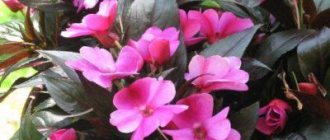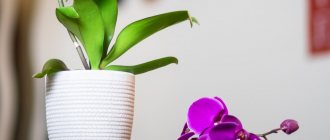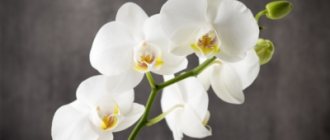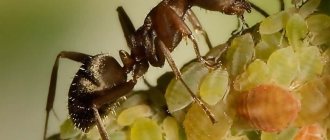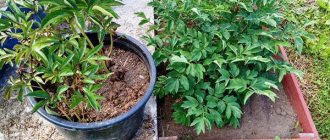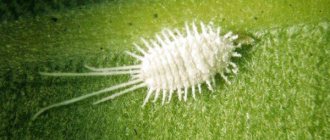Ants do not cause serious harm to peonies; they feed on the sweet nectar that forms on the buds. Flowers most often bloom normally, at the usual time. However, insects cannot be called completely harmless; they bring aphids to flowers in large quantities, and aphids damage the tissue of young leaves, destroy the smallest buds and are carriers of dangerous diseases.
To be closer to the food source, ants can settle near peony bushes; if their nest is located directly in the root zone, the plants will die over time due to malnutrition or the development of rot. Why do ants appear on peonies, how to get rid of them, how to treat buds and flowers: chemicals, traps and folk remedies.
Why do ants appear on peonies?
The ants' diet largely consists of carbohydrates, which they obtain by feeding on honeydew and the sweet nectar of certain plants. Insects are attracted to the sharp, sweet aroma of peony, emanating even from unopened flowers. Ants that settle on buds feed on the juice that has already been released; very rarely they gnaw through the bud in search of nectar.
On a note! Buds damaged by ants dry out or bloom, but the flowers become deformed and discolored.
If insects have already settled on peony bushes, they will bring aphids to them, which, in the process of vital activity, secrete honeydew - a food source for ants. Aphids reproduce very quickly, they destroy young leaves, buds and even peony flowers. Due to impaired photosynthesis, plants lose immunity to infections and cold resistance decreases.
About the tastes of insects
Many amateur gardeners wonder why there are ants on peonies. There are several reasons why ants love peonies. This plant seduces:
- Nectar. Ants hunt for nectar, which contains a lot of nutrients for insects.
- Protection. Quite often, ants make a nest under a peony bush, which perfectly camouflages their home.
- Food for aphids. Ants spread aphids, for which the petals and buds of peonies are considered one of their favorite delicacies.
Ants on peonies
How to get rid of ants before peonies bloom
To ensure that insects cause as little harm as possible, stems with small, newly formed buds (the size of a pea) are treated with various repellents. They use special gels - Agrus, Cleanbeit, Liquidator or folk remedies. This method has a significant disadvantage: during the budding period it often rains, water will wash away the substances, if you do not coat the stems again, the ants will reach the target again.
A good alternative is wood ash; as soon as the stems begin to grow, the powder is scattered in a circle near the trunk; it will not only repel ants, but will also nourish the plants. At the same time, make sure that there is no excess of potassium, phosphorus and calcium; in this case, the product cannot be used, otherwise the development of plants will be disrupted. Before and at the beginning of flowering, baits, traps and barriers are placed around the bushes.
Prevention measures
It is better to prevent ants on peonies than to get rid of pests later. It is necessary to regularly inspect the bush for insects, including aphids. If several individuals are found, they must be removed immediately, without giving a chance for further spread.
You must constantly ensure that anthills do not appear in your garden. When transplanting peonies to a new location, you need to add ash to the soil. It will not only help save peonies from ants, but will also be an excellent fertilizer for plantings. In the same bed with peonies, you can plant plants whose aroma will repel pests.
If you approach the process of caring for peonies correctly, you can grow beautiful flowers on your site to your delight and to the envy of your neighbors.
How to treat peony buds against ants
All means are good in the fight against ants, but you need to consider what plants, shrubs or trees are located in the neighborhood. Flowers are not treated with chemicals if there are apiaries nearby, berries, fruits, vegetables (with fruits already set) and herbs grow. The packages contain detailed information about the time period between use of the products and harvest.
Chemicals are not used if there is no goal to completely get rid of ants; in addition to harm, they bring benefits, they eat the larvae and caterpillars of some pests. Folk remedies are used throughout the summer; they are harmless to other plants, beneficial insects and the environment. Safe substances give a weak and short-term effect; treatments are repeated every 5–10 days.
All methods of fighting ants on peonies
It is useless to shake insects off peonies; a more effective method is to wash them off. Take settled water, heated by the sun, add a little laundry soap or dishwashing detergent (20 g per 5 liters of water), with a soft cloth, and carefully wash the buds. The procedure is permissible only in the morning and evening hours; if you rinse the flowers during the day, burns may remain on the sepals. The method gives a good result if there are few ants, but if there are a large number of individuals, they carry out a complex fight.
Store-bought drugs
When choosing chemicals, take into account that aerosols give a temporary effect; dead ants will quickly be replaced by new ones. Gels and most powder products (for preparing solutions) act on the digestive system of insects, substances are transferred from one individual to another, most often this leads to infection of the entire colony.
What drugs give good results:
- Ant-eater. A powder or liquid product containing diazinon, a potent poison that attacks the intestines of ants. In stores you can often find ampoules, 1 is enough for 10 liters of water.
- Expel. A German drug based on chlorpyrifos, it is also produced in the form of powder and emulsion. Use the product strictly according to the instructions, which may vary (depending on the form of release of the substance).
- Muratsid or Ant. They act in the same way as the first drug.
Attention! Solutions of any product cannot be stored; they are used immediately after preparation; they are used to treat bushes, soil around tree trunks, and anthills.
The downside of chemicals is that they are harmful to bees and other beneficial insects, as well as animals and birds. Failure to follow the instructions for use can lead to serious poisoning and other dangerous consequences (rash, irritation of the mucous membranes and skin). Plants are treated in the morning or evening in dry, windless weather; gloves, a mask and closed clothing are worn. Other commonly used drugs are Inta-vir, Grom, Vallar, Kapkan and Karbofos.
Traps
When placing baits with toxic substances, make sure that beneficial insects cannot get into them. For example, they take small plastic bottles or jars with rubber lids and make small holes so that only small individuals can fit through them freely.
Various preparations for traps can be bought in the store; the following have proven themselves to be good:
- Blattanex Ant Bait. Contains food additives, sugar. The ants eat the bait, carry it to their nests, spreading it throughout the entire anthill. The first individuals die within a few days; complete destruction takes from 2 to 8 weeks (in large numbers). The granules are scattered dry into prepared containers or in places where there are large concentrations of ants.
- Ameisen Aeroxon. It attracts insects and affects their nervous system, the ants carry it to the queen and brood, and within a short time the entire colony dies. With this remedy you can get rid of the problem within a day.
- Combat and Raptor. Special preparations consisting of several ready-made traps.
Purchased products are replaced with a composition of 5 g of boric acid, 50 g of honey and 50 g of water, the mixture is mixed until a homogeneous mass is obtained, transferred to a trap or scattered around the bushes. Having smelled the “treat”, the insects will leave the buds, and having tasted it, they will die. Instead of honey, you can use sugar or jam, the effect will be the same. In order not to destroy the ants, but simply to distract them from the peonies, prepare the usual sweet bait. Several small containers are filled with syrup, placed around the flower bed, and the liquid is added or changed daily.
Barriers
Barriers (ribbons, tying with cloth impregnated with insecticides, whitewashing, etc.) are more convenient to use on young trees or thin branches of shrubs, but there is also an option for peonies. A circle with a diameter of up to 16 cm is cut out of thick cardboard, a small hole is made in the center, the size of the stem, so that there is no gap left. The circle from the outer edge to the inner is cut and put on a twig, closer to the bud or flower. The bottom of the cardboard is generously greased with Vaseline.
Barriers like tires with water dug around bushes practically do not work. The first individuals fall into the trap, the rest break through passages under the barrier and freely reach the buds. This method of control is dangerous; in order not to lose their food source, insects build homes right in the root zone, and this inevitably leads to the death of peonies.
Repellent odors
A good way to prevent the appearance of ants on peonies is to use plants whose aroma they cannot tolerate: wormwood, tansy, marigolds, garlic, lavender, parsley, mint, anise and bay leaves. The latter can be taken dry (seasonings). Infusions are prepared from repellents for spraying; some of them are planted around the perimeter of the flower garden. Rub the stems of peonies with a clove of garlic until they bloom.
Attention! You can scare away ants with tobacco infusion. A glass of cigarette butts is poured into 5 liters of hot water, left for 2-3 days, filtered and sprayed on the plants.
Chop a large head or 100 g of garlic cloves, pour in 3 liters of boiling water, leave for a day in a closed container, filter, process the leaves, buds and stems on all sides. An infusion of any of the plants proposed above is prepared in the same way; a lot of herbs are taken so that the aroma is rich. A little laundry soap is added to the finished, strained infusions, so the liquid remains on the leaves longer.
The usual interval between treatments is 5–12 days; if it rains constantly, the bushes are sprayed more often. In cases where it is not possible to visit the dacha often, you can put a rag soaked in kerosene near the bushes (in the depths of the flower garden). The sharp, pungent smell will scare away ants and other harmful insects, but you won’t be able to enjoy the delicate aroma of flowers. Ants do not like the smell of conifers, but they cannot be used in beds with peonies, the needles acidify the soil, and plants develop well only in a neutral environment.
Folk remedies for ants on peonies
If for some reason it is not possible to treat plants with special chemical insecticides and acaricides, get rid of annoying insects using various means that are in the kitchen or in the medicine cabinet. The results from them are no worse, and some give a quick and long-term effect.
Let's highlight the already proven and most effective options:
- 1 tbsp. l. vinegar essence is diluted in a bucket of water, the bushes are irrigated with the mixture, and the buds are always treated.
- Baking powder is scattered in the root zone and along the perimeter of the flower bed. Take about 50–100 g of powder per 1 m². The ants die from such a treat, but the bait is used only in dry, windless weather.
- The soil around the bushes is loosened, a repellent mixture of soda, quicklime and wood ash is scattered over the surface, the ingredients are taken in equal parts. The same mixture is sprinkled on anthills.
On a note! If there are few ants on the buds, they can be sprayed with a weak soap solution, a teaspoon is enough. shampoo per 1 liter of water.
Small anthills located near peonies are filled with boiling water with the addition of soda ash - a pack per bucket. Instead of soda, use ammonia, 100 ml is enough for the same amount of liquid. A mixture of 250 ml of dishwashing detergent, 1 liter of table vinegar, 500 ml of oil per bucket of water gives good results, pour the liquid into large anthills. A small depression is made at the top, poured gradually, then the nest is covered with polyethylene, left for a day and dug deep.
What to do to prevent ants from appearing on peonies
Preventing insect attacks on flowers is much easier than fighting them. Prevention consists of regularly inspecting the area and destroying all anthills. The garden is always kept clean, garbage, sawdust, shavings, old boards, weeds, fallen leaves and other plant debris, branches are removed, and stumps from trees and shrubs are uprooted. When transplanting peonies from one place to another, wood ash is added to the holes and into the soil for backfilling. Repellent plants are planted in flower beds with peonies.
Getting rid of anthills on the site is painstaking work, but this is the only way to protect peonies. Ants are especially dangerous for weakened plants, as they are carriers of fungal infections. A constant companion of insects, aphids are capable of destroying young plants in a few days and infecting them with viral diseases. It is better to fight ants comprehensively, using various methods, this will guarantee a good result.
Did you like the post? Add it to your favorites
All your articles will be on this page.
Send the article to your social network!
Preventive measures
Simple measures will help you never encounter a problem:
- Every year in mid-April and October, treat the area around the perimeter with suitable insecticides or plant plants whose smell is unpleasant to ants;
- regularly inspect peonies to find the anthill in time - when it can still be moved without resorting to “heavy artillery”;
- When planting flowers where there used to be an anthill, carefully dig up the soil, adding wood ash (0.5 l/m²) to it.

